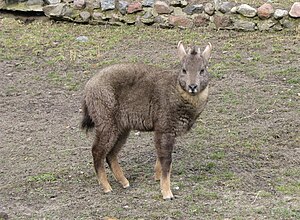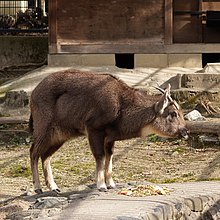Gorale
| Gorale | ||||||||||||
|---|---|---|---|---|---|---|---|---|---|---|---|---|

Long-tailed goral ( Naemorhedus caudatus ) |
||||||||||||
| Systematics | ||||||||||||
|
||||||||||||
| Scientific name | ||||||||||||
| Naemorhedus | ||||||||||||
| Smith , 1827 |
The gorals ( Naemorhedus ) are an Asiatic genus of goat-like . According to today's view, they comprise six types.
features
Gorals are stocky, goat-like animals. They reach a head body length of 82 to 130 centimeters, to which a tail 8 to 20 centimeters long comes. The shoulder height is 57 to 79 centimeters and the weight 22 to 35 kilograms. Both sexes have horns that are conical and slightly curved backwards and are 13 to 18 centimeters long.
The fur is long and dense, its color is gray, dark brown or fox red depending on the species. All species have a white throat and a black eel line . Males are also characterized by a short mane on the neck.
distribution and habitat
Gorals are native to East Asia , their distribution area ranges from Kashmir in the west and southeastern Siberia in the north to Myanmar and Thailand in the southeast. Their habitat is usually wooded mountains at altitudes of 1000 to 4000 meters.
Way of life
Gorals are excellent climbers who have adapted to extremely rough terrain. They are mainly active in the morning and late afternoon, when they are resting they often lie on rocks, where they can hardly be made out due to the color of their fur. They live in groups of 4 to 12 animals, while older males are solitary animals. During the mating season between September and December, the males try to gain control of a group of females.
Their diet consists of grasses, leaves, twigs and nuts.
After a six to eight month gestation period, the female gives birth to one or two young.
Systematics and naming
|
Internal systematics of the Gorals according to Xiong et al. 2013
|

Originally only four species were differentiated within the Gorale, a revision of the horned bearers from 2011 by Colin Peter Groves and Peter Grubb recognized a total of six species:
- Red goral or Tibetan goral ( Naemorhedus baileyi Pocock , 1914); eastern Himalayas in the border area of Assam, Yunnan, Tibet and Myanmar. The Tibetan goral ( N. cranbrooki ), sometimes referred to as a separate species, is con-specific with the red goral.
- West Himalayan goral ( Naemorhedus bedfordi ( Lydekker , 1905)); Pakistan and Northwest India (Kashmir).
- Long-tailed goral or North China goral ( Naemorhedus caudatus ( Milne-Edwards , 1876)); southeastern Siberia, northeastern China and Korea.
- Burma goral ( Naemorhedus evansi ( Lydekker , 1905)): central and southern Myanmar, Thailand, in the north to the Chinese province of Yunnan .
- Gray goral or East Himalayan goral ( Naemorhedus goral ( Hardwicke , 1825)); western Himalayas from northern India via Nepal and Bhutan to Assam.
- Chinese goral or western China goral ( Naemorhedus griseus ( Milne-Edwards , 1871)); China (from Inner Mongolia to Yunnan).
For a long time, the Burma goral was considered a subspecies of the Chinese goral, while the West Himalayan goral was a local form of the gray goral. Several molecular genetic studies have shown, however, that the Chinese goral and the Burma goral differ by 6.9% of their genetic material. The gap between the Burma Goral and the Red Goral is only 4%, so both are considered to be more closely related. Thus, the genetic results also support the independence of the Burma Goral. In addition, both species form the most primitive group within the genus. The Chinese Goral, on the other hand, is closer to the Gray Goral. The Seraue ( Capricornis ), which were sometimes incorporated into the Gorale, turned out to be an independent, monophyletic group.
The generic name is derived from the Latin nemus , genitive nemoris (= "forest") and haedus (= "goat") and should therefore actually be written Nemorhaedus . However, the first descriptor, Charles Hamilton Smith , used the spelling Naemorhedus , which is therefore valid. There are also the (invalid) spellings Naemorhaedus , Nemorhaedus , Nemorhedus , Nemorrhaedus and Nemorrhedus .
literature
- Colin Groves and Peter Grubb: Ungulate Taxonomy. Johns Hopkins University Press, 2011, pp. 1–317 (SS 108–280)
- Colin P. Groves and David M. Leslie Jr .: Family Bovidae (Hollow-horned Ruminants). In: Don E. Wilson and Russell A. Mittermeier (eds.): Handbook of the Mammals of the World. Volume 2: Hooved Mammals. Lynx Edicions, Barcelona 2011, ISBN 978-84-96553-77-4 , pp. 743-745
- Ronald M. Nowak: Walker's Mammals of the World. Johns Hopkins University Press, 1999, ISBN 0-8018-5789-9
- DE Wilson, DM Reeder: Mammal Species of the World . Johns Hopkins University Press, Baltimore 2005. ISBN 0-8018-8221-4
Individual evidence
- ↑ a b Zhenhuan Xiong, Min Chen, Endi Zhang and Mingjian Huang: Molecular phylogeny and taxonomic status of the red goral by cytbgene analyzes. Folia Zoologica 62 (2), 2013, pp. 125-129
- ↑ Don E. Wilson, DeeAnn M. Reeder (Ed.): Mammal Species of the World. 3rd edition. The Johns Hopkins University Press, Baltimore 2005, ISBN 0-8018-8221-4 ( [1] )
- ↑ Colin P. Groves and David M. Leslie Jr .: Family Bovidae (Hollow-horned Ruminants). In: Don E. Wilson and Russell A. Mittermeier (eds.): Handbook of the Mammals of the World. Volume 2: Hooved Mammals. Lynx Edicions, Barcelona 2011, ISBN 978-84-96553-77-4 , pp. 743-745
- ↑ Colin Groves and Peter Grubb: Ungulate Taxonomy. Johns Hopkins University Press, 2011, pp. 1–317 (SS 108–280)
- ↑ Alexandre Hassanin, Frédéric Delsuc, Anne Ropiquet, Catrin Hammer, Bettine Jansen van Vuuren, Conrad Matthee, Manuel Ruiz-Garcia, François Catzeflis, Veronika Areskoug, Trung Thanh Nguyen and Arnaud Couloux: Pattern and timing of diversification of Cetartiodactalia, Lauriala (Mammia ), as revealed by a comprehensive analysis of mitochondrial genomes. Comptes Rendus Palevol 335, 2012, pp. 32-50
- ↑ Alexandre Hassanin, Anne Ropiquet, Arnaud Couloux and Corinne Cruaud: Evolution of the Mitochondrial Genome in Mammals Living at High Altitude: New Insights from a Study of the Tribe Caprini (Bovidae, Antilopinae). Journal of Molecular Evolution 68, 2009, pp. 293-310